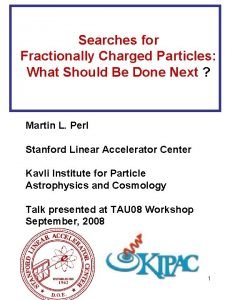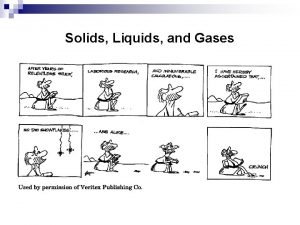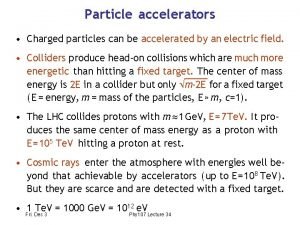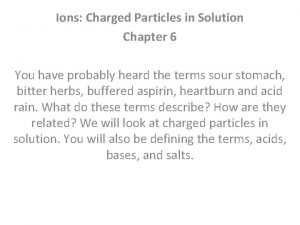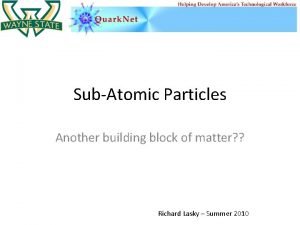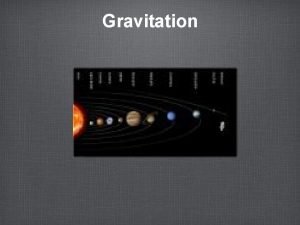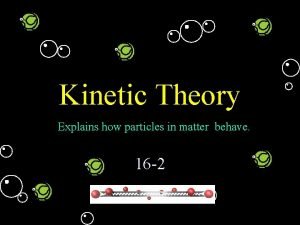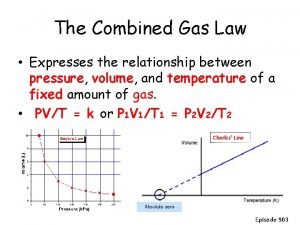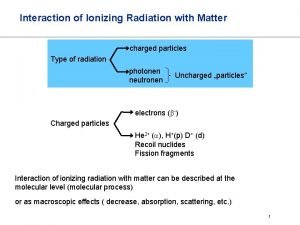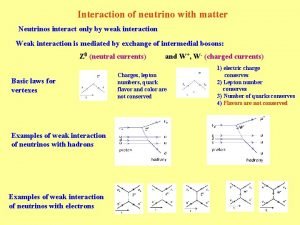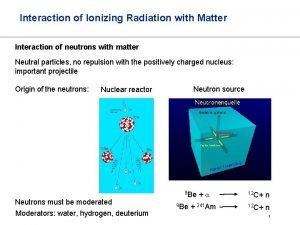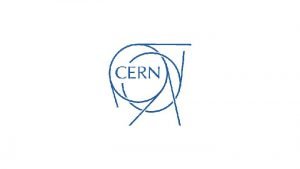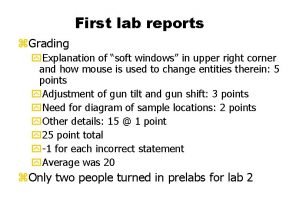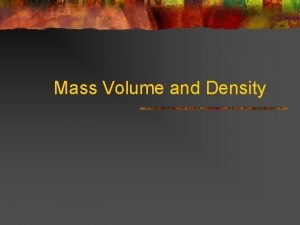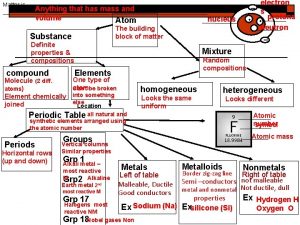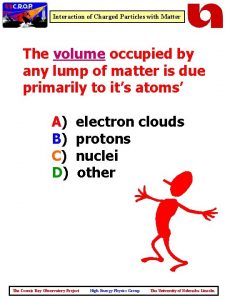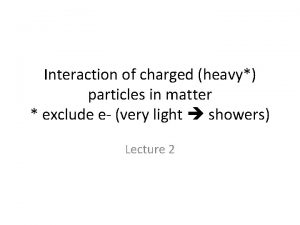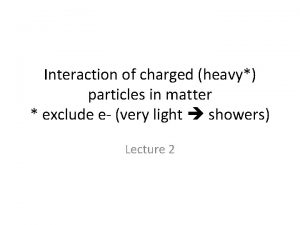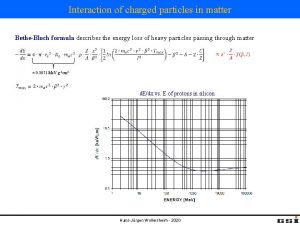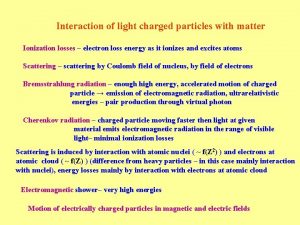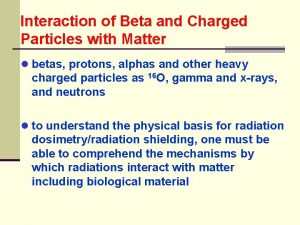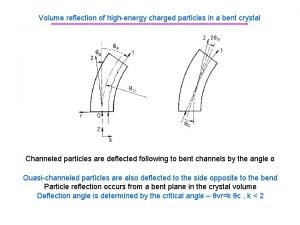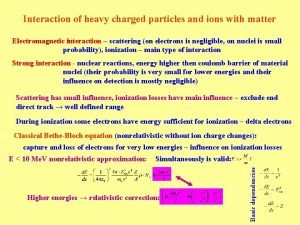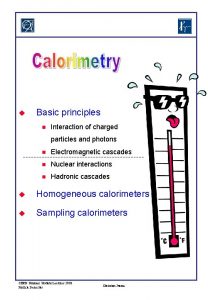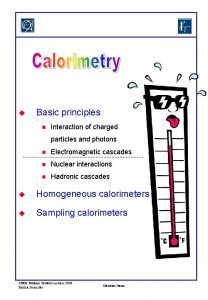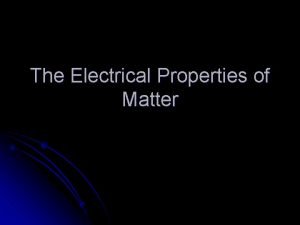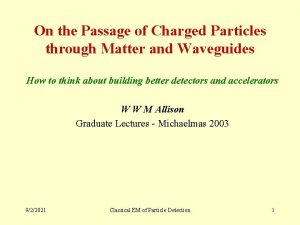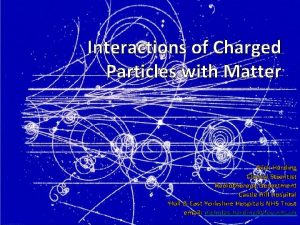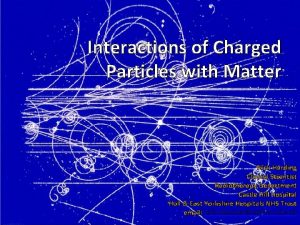Interaction of Charged Particles with Matter The volume


















































![Interaction of Charged Particles with Matter bg Muon momentum [Ge. V/c] Particle Data Group, Interaction of Charged Particles with Matter bg Muon momentum [Ge. V/c] Particle Data Group,](https://slidetodoc.com/presentation_image_h2/6318b9ece292061652473604e05a1d32/image-51.jpg)

- Slides: 52

Interaction of Charged Particles with Matter The volume occupied by any lump of matter is due primarily to it’s atoms’ A) B) C) D) electron clouds protons nuclei other The Cosmic Ray Observatory Project High Energy Physics Group The University of Nebraska-Lincoln

Interaction of Charged Particles with Matter The mass of matter is due primarily to it’s A) electron cloud B) nuclei C) other The Cosmic Ray Observatory Project High Energy Physics Group The University of Nebraska-Lincoln

Interaction of Charged Particles with Matter If atoms are mostly empty space, why don’t we just fall through the floor? A) B) C) D) E) electrical forces magnetic forces gravitational forces nuclear forces atoms are not mostly empty space The Cosmic Ray Observatory Project High Energy Physics Group The University of Nebraska-Lincoln

Interaction of Charged Particles with Matter Earth The Cosmic Ray Observatory Project Moon High Energy Physics Group The University of Nebraska-Lincoln

Interaction of Charged Particles with Matter Earth The Cosmic Ray Observatory Project Moon High Energy Physics Group The University of Nebraska-Lincoln

Interaction of Charged Particles with Matter for some sense of spacing consider the ratio orbital diameters central body diameter ~ 10 s for moons/planets ~100 s for planets orbiting sun In a solid • interatomic spacing: 1 -5 Å (1 -5 10 -10 m) • nuclear radii: 1. 5 -5 fm (1. 5 -5 10 -15 m) the ratio orbital diameters central body diameter ~ 66, 666 for atomic electron orbitals to their own nucleus A basketball scale nucleus would have its family of electrons stretching 10 s of miles away The Cosmic Ray Observatory Project High Energy Physics Group The University of Nebraska-Lincoln

Interaction of Charged Particles with Matter Carbon Oxygen Aluminum Iron Copper Lead 6 C 8 O 13 Al 26 Fe 29 Cu 82 Pb What about a single, high energy, charged particle? The Cosmic Ray Observatory Project High Energy Physics Group The University of Nebraska-Lincoln

Interaction of Charged Particles with Matter A solid sheet of lead offers how much of a (cross sectional) physical target (and how much empty space) to a subatomic projectile? 207 Pb 82 w Number density, n: number of individual atoms (or scattering centers!) per unit volume n= r. NA / A where NA = Avogadro’s Number A = atomic “weight” (g) r = density (g/cc) n= (11. 3 g/cc)(6. 02 1023/mole)/(207. 2 g/mole) = 3. 28 1022/cm 3 The Cosmic Ray Observatory Project High Energy Physics Group The University of Nebraska-Lincoln

Interaction of Charged Particles with Matter 207 Pb 82 w For a thin enough layer n (Volume) (atomic cross section) = n (surface area, A w)(pr 2) 5 10 -15 m as a fraction of the target’s area: = n (w)p(5 10 -13 cm)2 The Cosmic Ray Observatory Project High Energy Physics Group The University of Nebraska-Lincoln

Interaction of Charged Particles with Matter 207 Pb 82 w For a thin enough layer n (w)p(5 10 -13 cm)2 For 1 mm sheet of lead: 1 cm sheet of lead: The Cosmic Ray Observatory Project High Energy Physics Group 0. 00257 0. 0257 The University of Nebraska-Lincoln

Interaction of Charged Particles with Matter Actually a projectile “sees” nw nuclei per unit area but Znw electrons per unit area! The Cosmic Ray Observatory Project High Energy Physics Group The University of Nebraska-Lincoln

Interaction of Charged Particles with Matter We’ve named 3 forms of natural terrestrial radiation a b g How did these rank in ionizing power? The Cosmic Ray Observatory Project High Energy Physics Group The University of Nebraska-Lincoln

Interaction of Charged Particles with Matter We’ve named 3 forms of natural terrestrial radiation a 1 b 2 g 3 How did these rank in ionizing power? in penetrability(range)? The Cosmic Ray Observatory Project High Energy Physics Group The University of Nebraska-Lincoln

Interaction of Charged Particles with Matter We’ve named 3 forms of natural terrestrial radiation a b g 1 2 3 How did these rank in ionizing power? 3 2 1 in penetrability(range)? Can you suggest WHY there is this inverse relationship between ionization and penetrability? “ionizing” radiation The Cosmic Ray Observatory Project High Energy Physics Group The University of Nebraska-Lincoln

Interaction of Charged Particles with Matter mproton = 0. 000 000 001 6748 kg melectron=0. 000 000 0009 kg The Cosmic Ray Observatory Project High Energy Physics Group The University of Nebraska-Lincoln

Interaction of Charged Particles with Matter Momentum is inertia of motion While inertia depends on mass Easy to start Hard to start Momentum “Quantity of motion” depends on mass and velocity Easy to stop m v v Hard to stop m m v v momentum = mass velocity The Cosmic Ray Observatory Project High Energy Physics Group The University of Nebraska-Lincoln

To change velocity Force Interaction of Charged Particles with Matter To change momentum Impulse = force × time p = F t Ft p Ft = p F t = p (breaks) (doesn’t break) The Cosmic Ray Observatory Project High Energy Physics Group The University of Nebraska-Lincoln

Interaction of Charged Particles with Matter A bowling ball and ping-pong ball are rolling towards you with the same momentum. Which ball is moving toward you with the greater speed? A) the bowling ball B) the ping pong ball C) same speed for both The Cosmic Ray Observatory Project High Energy Physics Group The University of Nebraska-Lincoln

Interaction of Charged Particles with Matter v A fast moving car traveling with a speed v rear-ends an identical model (and total mass) car idling in neutral at the intersection. They lock bumpers on impact and move forward at A) B) C) D) The Cosmic Ray Observatory Project 0 (both stop). v/4 v/2 v High Energy Physics Group The University of Nebraska-Lincoln

Interaction of Charged Particles with Matter A heavy truck and light car both traveling at the speed limit v, have a head-on collision. If they lock bumpers on impact they skid together to the A) right B) left Under what conditions would they stop dead? The Cosmic Ray Observatory Project High Energy Physics Group The University of Nebraska-Lincoln

Interaction of Charged Particles with Matter A 100 kg astronaut at rest catches a 50 kg meteor moving toward him at 9 m/sec. If the astronaut manages to hold onto the meteor after catching it, what speed does he pick up? A) B) C) D) E) F) 3 m/sec 4. 5 m/sec 9 m/sec 15 m/sec 18 m/sec some other speed The Cosmic Ray Observatory Project High Energy Physics Group The University of Nebraska-Lincoln

Interaction of Charged Particles with Matter v mv (m+m)v mv The Cosmic Ray Observatory Project High Energy Physics Group mv The University of Nebraska-Lincoln

Interaction of Charged Particles with Matter Car A has a mass of 900 kg and is travelling east at a speed of 10 m/sec. Car B has a mass of 600 kg and is travelling north at a speed of 25 m/sec. The two cars collide, and lock bumpers. Neglecting friction which arrow best represents the direction the combined wreck travels? A B C 600 kg 25 m/sec 900 kg 10 m/sec The Cosmic Ray Observatory Project High Energy Physics Group The University of Nebraska-Lincoln

Interaction of Charged Particles with Matter The Cosmic Ray Observatory Project High Energy Physics Group The University of Nebraska-Lincoln

Interaction of Charged Particles with Matter The Cosmic Ray Observatory Project High Energy Physics Group The University of Nebraska-Lincoln

Interaction of Charged Particles with Matter A light particle of charge q 1 encounters (passes by, not directly hitting) a heavy particle of charge q 2 at rest, b q 2 b “impact” parameter The Cosmic Ray Observatory Project High Energy Physics Group q 1 The University of Nebraska-Lincoln

Interaction of Charged Particles with Matter A light particle of charge q 1 encounters (passes by, not directly hitting) a heavy particle of charge q 2 at rest, b q 2 b “impact” parameter The Cosmic Ray Observatory Project High Energy Physics Group q 1 The University of Nebraska-Lincoln

Interaction of Charged Particles with Matter A light particle of charge q 1 encounters (passes by, not directly hitting) a heavy particle of charge q 2 at rest, b q 2 b “impact” parameter The Cosmic Ray Observatory Project High Energy Physics Group q 1 The University of Nebraska-Lincoln

Interaction of Charged Particles with Matter A light particle of charge q 1 encounters (passes by, not directly hitting) a heavy particle of charge q 2 at rest, and follows a HYPERBOLIC TRAJECTORY b q 2 F' F b “impact” parameter The Cosmic Ray Observatory Project High Energy Physics Group q 1 The University of Nebraska-Lincoln

Interaction of Charged Particles with Matter A light particle of charge q 1 encounters (passes by, not directly hitting) a heavy particle of charge q 2 at rest, and follows a HYPERBOLIC TRAJECTORY F' b q 2 F For an attractive “central” force the heavy charge occupies the focus of the trajectory like the sun does for a comet sweeping past the sun (falling from and escaping back to distant space). The Cosmic Ray Observatory Project High Energy Physics Group q 1 The University of Nebraska-Lincoln

Interaction of Charged Particles with Matter A light particle of charge q 1 encounters (passes by, not directly hitting) a heavy particle of charge q 2 at rest, and follows a HYPERBOLIC TRAJECTORY b q 2 F´ F q 1 The Cosmic Ray Observatory Project High Energy Physics Group The University of Nebraska-Lincoln

Interaction of Charged Particles with Matter b q 2 Larger deflection smaller m larger q much smaller v 0 smaller b The Cosmic Ray Observatory Project High Energy Physics Group q 1 The University of Nebraska-Lincoln

Interaction of Charged Particles with Matter Relaxing the “light”, “heavy” requirement simply means BOTH will move in response to the forces between them. q 2 Recoil of target q 1 The Cosmic Ray Observatory Project High Energy Physics Group The University of Nebraska-Lincoln

Interaction of Charged Particles with Matter Relaxing the “light”, “heavy” requirement simply means BOTH will move in response to the forces between them. q 1 q 2 Recoil of target q 1 The Cosmic Ray Observatory Project High Energy Physics Group The University of Nebraska-Lincoln

Interaction of Charged Particles with Matter What about the ENERGY LOST in the collision? • the recoiling target carries energy • some of the projectile’s energy was surrendered • if the target is heavy • the recoil is small • the energy loss is insignificant Reminder: 1/ (3672 Z) The Cosmic Ray Observatory Project High Energy Physics Group The University of Nebraska-Lincoln

Interaction of Charged Particles with Matter A projectile with initial speed v 0 scatters off a target (as shown) with final speed vf. mvf mv 0 The direction its target is sent recoiling is best represented by B C A D T E G The Cosmic Ray Observatory Project F High Energy Physics Group The University of Nebraska-Lincoln

Interaction of Charged Particles with Matter A projectile with initial speed v 0 scatters off a target (as shown) with final speed vf. mvf mv 0 The sum of the final momentum (the scattered projectile and the recoiling target) must be the same as the initial momentum of the projectile! F The Cosmic Ray Observatory Project High Energy Physics Group The University of Nebraska-Lincoln

Interaction of Charged Particles with Matter mvf mv 0 mvf mv 0 The Cosmic Ray Observatory Project High Energy Physics Group The University of Nebraska-Lincoln

Interaction of Charged Particles with Matter mvf mv 0 mvf ( (mv) = - mv 0 The Cosmic Ray Observatory Project High Energy Physics Group recoil momentum of target ) The University of Nebraska-Lincoln

If scattering ( Particles ) is small Interaction of Charged with Matter • large impact parameter b and/or • large projectile speed v 0 vf vo mvf /2 p /2 mv 0 C Recall sin a = B/C The Cosmic Ray Observatory Project High Energy Physics Group B A The University of Nebraska-Lincoln

Interaction of Charged Particles with Matter mvf /2 p /2 mv 0 Together with: The Cosmic Ray Observatory Project High Energy Physics Group The University of Nebraska-Lincoln

Interaction of Charged Particles with Matter Recognizing that all charges are simple multiples of the fundamental unit of the electron charge e, we can write q 1 = Z 1 e The Cosmic Ray Observatory Project q 2 = Z 2 e High Energy Physics Group The University of Nebraska-Lincoln

Interaction of Charged Particles with Matter Z 2≡Atomic Number, the number of protons (or electrons) q 2=Z 2 e q 1=Z 1 e The Cosmic Ray Observatory Project High Energy Physics Group The University of Nebraska-Lincoln

Interaction of Charged Particles with Matter Recalling that kinetic energy K = ½mv 2 = (mv)2/(2 m) the transmitted kinetic energy (the energy lost in collision to the target) K = ( p)2/(2 mtarget) The Cosmic Ray Observatory Project High Energy Physics Group The University of Nebraska-Lincoln

Interaction of Charged Particles with Matter For nuclear collisions: mtarget 2 Z 2 mproton For collisions with atomic electrons: mtarget melectron q 2 = 1 e for an encounter with 1 electron The Cosmic Ray Observatory Project High Energy Physics Group The University of Nebraska-Lincoln

Interaction of Charged Particles with Matter For nuclear collisions: mtarget 2 Z 2 mproton For collisions with atomic electrons: mtarget melectron q 1 = 1 e Z 2 times as many of these occur! The Cosmic Ray Observatory Project High Energy Physics Group The University of Nebraska-Lincoln

Interaction of Charged Particles with Matter The energy loss due to collisions with electrons is GREATER by a factor of The Cosmic Ray Observatory Project High Energy Physics Group The University of Nebraska-Lincoln

Interaction of Charged Particles with Matter Notice this simple approximation shows that Why are a-particles “more ionizing” than b-particles? The Cosmic Ray Observatory Project High Energy Physics Group The University of Nebraska-Lincoln

Interaction of Charged Particles with Matter energy loss speed The Cosmic Ray Observatory Project High Energy Physics Group The University of Nebraska-Lincoln

Interaction of Charged Particles with Matter Felix Bloch Hans Bethe -d. E/dx = (4 p. Noz 2 e 4/mev 2)(Z/A)[ln{2 mev 2/I(1 -b 2)}-b 2] I = mean excitation (ionization) potential of atoms in target ~ Z 10 e. V 103 Range of d. E/dx for proton through various materials d. E/dx ~ 1/b 2 102 H 2 gas target 101 Pb target Logarithmic rise 100 101 102 The Cosmic Ray Observatory Project E (Me. V) High Energy Physics Group 104 105 106 The University of Nebraska-Lincoln
![Interaction of Charged Particles with Matter bg Muon momentum Ge Vc Particle Data Group Interaction of Charged Particles with Matter bg Muon momentum [Ge. V/c] Particle Data Group,](https://slidetodoc.com/presentation_image_h2/6318b9ece292061652473604e05a1d32/image-51.jpg)
Interaction of Charged Particles with Matter bg Muon momentum [Ge. V/c] Particle Data Group, R. M. Barnett et al. , Phys. Rev. D 54 (1996) 1; Eur. Phys. J. C 3 (1998) The Cosmic Ray Observatory Project High Energy Physics Group The University of Nebraska-Lincoln

Interaction of Charged Particles with Matter D. R. Nygren, J. N. Marx, Physics Today 31 (1978) 46 d. E/dx(ke. V/cm) m a p p d e Momentum [Ge. V/c] The Cosmic Ray Observatory Project High Energy Physics Group The University of Nebraska-Lincoln
 For charged particles, what is the quantity q/m called?
For charged particles, what is the quantity q/m called? The search for fractionally charged particles has
The search for fractionally charged particles has Gas like mixture of charged particles
Gas like mixture of charged particles Charged particles can be accelerated by
Charged particles can be accelerated by Chapter 6 ions charged particles in solution
Chapter 6 ions charged particles in solution Building block of matter which contains subatomic particles
Building block of matter which contains subatomic particles The mutual force of attraction between particles of matter
The mutual force of attraction between particles of matter An explanation of how particles in matter behave
An explanation of how particles in matter behave Relationships between pressure volume and temperature
Relationships between pressure volume and temperature Ionizing radiation
Ionizing radiation Neutrino interaction with matter
Neutrino interaction with matter What is interaction of radiation with matter
What is interaction of radiation with matter Interaction volume
Interaction volume Interaction volume
Interaction volume Arbor vitae
Arbor vitae Flow energy review
Flow energy review Grey matter reliaquest
Grey matter reliaquest Classification of matter section 1 composition of matter
Classification of matter section 1 composition of matter Section 1 composition of matter
Section 1 composition of matter Classification of matter section 1 composition of matter
Classification of matter section 1 composition of matter Gray matter and white matter
Gray matter and white matter Chapter 2 section 1 classifying matter answer key
Chapter 2 section 1 classifying matter answer key Frontal and parietal lobes
Frontal and parietal lobes Properties of matter volume
Properties of matter volume V=density/mass
V=density/mass Anything that has mass and volume
Anything that has mass and volume Lung capacity
Lung capacity Heart stroke volume
Heart stroke volume Volume kerucut = .....x volume tabung *
Volume kerucut = .....x volume tabung * Stroke volume normal
Stroke volume normal Solute
Solute Formulation of large volume parenterals
Formulation of large volume parenterals Lời thề hippocrates
Lời thề hippocrates Vẽ hình chiếu đứng bằng cạnh của vật thể
Vẽ hình chiếu đứng bằng cạnh của vật thể Quá trình desamine hóa có thể tạo ra
Quá trình desamine hóa có thể tạo ra Các môn thể thao bắt đầu bằng tiếng bóng
Các môn thể thao bắt đầu bằng tiếng bóng Hát kết hợp bộ gõ cơ thể
Hát kết hợp bộ gõ cơ thể Sự nuôi và dạy con của hổ
Sự nuôi và dạy con của hổ Dạng đột biến một nhiễm là
Dạng đột biến một nhiễm là Nguyên nhân của sự mỏi cơ sinh 8
Nguyên nhân của sự mỏi cơ sinh 8 Trời xanh đây là của chúng ta thể thơ
Trời xanh đây là của chúng ta thể thơ độ dài liên kết
độ dài liên kết Voi kéo gỗ như thế nào
Voi kéo gỗ như thế nào Thiếu nhi thế giới liên hoan
Thiếu nhi thế giới liên hoan Tia chieu sa te
Tia chieu sa te điện thế nghỉ
điện thế nghỉ Một số thể thơ truyền thống
Một số thể thơ truyền thống Thế nào là hệ số cao nhất
Thế nào là hệ số cao nhất Hệ hô hấp
Hệ hô hấp Frameset trong html5
Frameset trong html5 Số nguyên tố là
Số nguyên tố là đặc điểm cơ thể của người tối cổ
đặc điểm cơ thể của người tối cổ Cách giải mật thư tọa độ
Cách giải mật thư tọa độ

